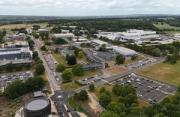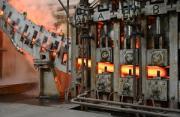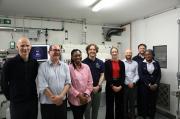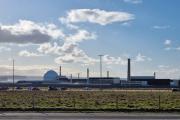GONE IN 90 SECONDS.....DOUNREAY CLEAN-UP ACCELERATED IN NEW VIDEO
3rd February 2008
It's already been cut from 100 years to 25 years. Now, the timescale for cleaning up and knocking down Dounreay has been accelerated to just 90 seconds in a new video showing how the site will look when decommissioning is complete.
The animated flyover shows how the site will disappear over the coming years as more of the fast reactor experiment is cleaned out and demolished.
Demolition of the site's fuel fabrication plant earlier this month took the total to 100 facilities to have been cleared so far.
An intensive phase of work over the next decade or so will see major facilities such as reactor buildings and reprocessing plants also disappear from the skyline.
By the time the clean-up is complete, all that is likely to remain in place are secure stores for up to 15,000 cubic metres of intermediate-level waste and fuels from the clean-up programme.
Up to 175,000 cubic metres of low-level waste from the clean-up is earmarked for disposal in a series of adjacent vaults currently the subject of a planning application.
A final decision has yet to be taken on whether to keep the contaminated 1950s sphere that housed the first of the site's three reactors.
The current programme agreed with the Nuclear Decommissioning Authority, which owns Dounreay, is for the clean-up to be complete by 2032.
Site contractor UKAEA, supported by its business partners AMEC and CH2MHILL, is bringing forward proposals to accelerate this timescale further,
Site programme manager Alistair Macdonald of UKAEA said: "There are overwhelming safety, security and environmental reasons for decommissioning Dounreay as quickly as it is safe to do so.
"We've shown several times already that we can complete the clean-up on an earlier timescale and we're confident we can improve our planning estimates even further to bring in the completion date from its current position in 2032.
"I don't think we will ever reduce it to 90 seconds but the video does give the public a good impression of our focus on accelerating the clean-up and managing the wastes in a way that makes them safe and secure for future generations."
The video - produced by site services contractor Johnson Controls for UKAEA - can be viewed at http://www.ukaea.org.uk/sites/video_clips.html
Related Businesses
Related Articles
UKAEA develops 3D printing for fusion components
At its recently opened Central Support Facility (CSF), UKAEA has commissioned an electron beam additive manufacturing machine that can be used to incorporate tungsten into components, alongside a selective laser manufacturing machine. Fusion can play a key role in a global low carbon energy future.Advancing Fusion Remote Maintenance: Industry Collaboration Driving Innovation
As part of the Fusion Futures (FF) programme, UKAEA's Remote Applications in Challenging Environments (RACE) has partnered with industry leaders to develop two groundbreaking technologies for remote maintenance in fusion energy engineering. Thanks to FF funding, industry has taken the lead in maturing UKAEA technology concepts—delivering real-world solutions that enhance operational autonomy and reduce maintenance burdens in extreme environments.UKAEA launches International Fellowships Scheme for fusion
UKAEA has launched the International Fellowships Scheme, an initiative to help expand the global talent pool supporting the fusion industry. The scheme is part of the UKAEA's Fusion Opportunities in Skills, Training, Education and Research (FOSTER) Programme, which aims to train, support, and empower the next generation of professionals, who will help deliver fusion power to the grid.Kyoto Fusioneering and Astral Systems join Culham fusion hub
UKAEA's Culham Campus welcomes Kyoto Fusioneering and Astral Systems as its latest tenants. Two pioneering companies, Kyoto Fusioneering and Astral Systems, have joined the growing cluster of fusion technology and AI organisations at United Kingdom Atomic Energy Authority's (UKAEA) Culham Campus.
Fusion-grade Steel Produced At Scale In UK-first
Researchers achieve 10x production cost savings for reduced activation steel. A United Kingdom Atomic Energy Authority (UKAEA) working group has successfully demonstrated the industrial scale production of fusion-grade steel.
UKAEA To Lead The Creation Of A Robotics And AI Cluster
UKAEA will lead the creation of a new £4.9m nuclear robotics and artificial intelligence cluster across Cumbria and Oxfordshire. The robotics and AI cluster was announced by UK Research and Innovation (UKRI) as one of seven new projects to kickstart economic growth and address regional needs: www.ukri.org The robotics and AI cluster will link Cumbria and Oxfordshire to accelerate the decommissioning of the UK's legacy nuclear fission facilities and keep people out of hazardous environments.
Diamonds Are Forever? World-first Carbon-14 Diamond Battery Made In Uk
The world's first carbon-14 diamond has been produced with the potential to provide power for thousands of years. Scientists and engineers from the UK Atomic Energy Authority (UKAEA) and the University of Bristol have successfully created the world's first carbon-14 diamond battery.
UKAEA Monthly Newsletter Latest Edition
Find out what has been happening at UKAEA in our monthly newsletter. Read about our recent activities and upcoming events.
UKAEA Newsletter - Edition 11 Published Today
Find out what has been happening at UKAEA in our monthly newsletter. Read about our recent activities and upcoming events.
Corwm Visits Dounreay Nuclear Site
Members were given an overview of the scale of the problem and challenges faced in the decommissioning of the site. In the last week of March 2024, several members of CoRWM led by the Chair, Sir Nigel Thrift, made the long journey up to the North of Scotland to visit the Dounreay nuclear site, now managed by Nuclear Restoration Services.
